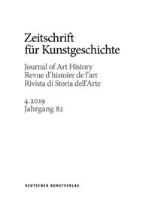
ZEITSCHRIFT FUR KUNSTGESCHICHTE
Scope & Guideline
Advancing Scholarly Dialogue in the Arts
Introduction
Aims and Scopes
- Interdisciplinary Research in Art History:
The journal promotes interdisciplinary methodologies, integrating perspectives from sociology, anthropology, and philosophy to enhance the understanding of art and its societal implications. - Focus on Historical Contexts:
A significant emphasis is placed on the historical contexts of art production, including political, social, and cultural factors that influence artistic practices across different eras. - Exploration of Materiality and Technique:
The journal frequently examines the material aspects of art, including the study of techniques, mediums, and the physical properties of artworks, which contributes to a deeper understanding of artistic practices. - Critical Engagement with Contemporary Issues:
Recent publications reflect a commitment to addressing contemporary themes in art history, such as race, identity, and the impact of technology, making the journal relevant to current academic and cultural discussions. - Global Perspectives in Art History:
The journal increasingly incorporates global perspectives, moving beyond Eurocentric narratives to include diverse artistic traditions and histories from around the world.
Trending and Emerging
- Ecological Perspectives in Art History:
Recent works increasingly address the ecological imperative, reflecting a growing awareness of environmental issues and their implications for art and artistic practices. - Exploration of Race and Identity:
There is a rising trend in examining race, identity, and representation in art, which is crucial for understanding the complexities of visual culture in a globalized world. - Intersections of Art and Science:
Emerging themes that explore the intersections between art and science, including materiality and technology, highlight the relevance of scientific discourse within art historical research. - Postcolonial Studies in Art History:
A notable increase in postcolonial studies reflects a broader commitment to understanding the impact of colonial histories on art and visual culture, pushing for more inclusive narratives. - Digital Art and New Media:
The exploration of digital art and new media is gaining momentum, as scholars investigate the implications of technology on artistic practices and the dissemination of art.
Declining or Waning
- Traditional Canonical Studies:
There has been a noticeable decrease in articles strictly adhering to traditional canonical studies of Western art, suggesting a shift towards more inclusive and diverse narratives that challenge established hierarchies. - Connoisseurship and Attribution Studies:
The focus on connoisseurship and the attribution of artworks has waned, as the field moves towards broader contextual analyses and interdisciplinary approaches that prioritize cultural significance over stylistic classification. - Static Historical Narratives:
There is a declining interest in static historical narratives that do not engage with contemporary issues or interdisciplinary perspectives, as the journal seeks to reflect more dynamic and nuanced understandings of art history. - Exclusive Focus on European Art:
The journal is gradually moving away from an exclusive focus on European art, indicating a waning interest in articles that do not incorporate global or comparative perspectives. - Formalism in Art Analysis:
Formal analysis, which emphasizes visual elements like line, color, and composition, appears to be losing traction, giving way to approaches that consider broader cultural, social, and political contexts.
Similar Journals
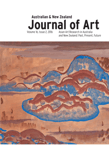
Australian and New Zealand Journal of Art
Cultivating Insightful Critique in the ArtsThe Australian and New Zealand Journal of Art, published by Taylor & Francis Ltd, stands as a critical platform for scholarly discourse in the fields of art, visual arts, and performing arts, contributing to the ongoing dialogue regarding contemporary artistic practices and methodologies across Australia and New Zealand. With an ISSN of 1443-4318 and an E-ISSN of 2203-1871, this journal invites submissions that strive for innovation and insightful critique, aiming to foster a deeper appreciation and understanding of diverse artistic expressions. Despite its classification in the fourth quartile under the Arts and Humanities categories, it continues to attract attention within its niche, as evidenced by its Scopus rankings, indicating its vital role in the academic landscape. The journal is committed to bridging the gap between research and practice, providing access to a wealth of interdisciplinary knowledge for researchers, professionals, and students alike.
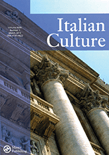
Italian Culture
Illuminating the Dynamics of Contemporary Italian ArtsItalian Culture is a critical scholarly journal published by Routledge Journals, Taylor & Francis Ltd, focusing on the multifaceted nature of Italian cultural expressions from the 1970s to the present day. With an ISSN of 0161-4622 and an E-ISSN of 1559-0909, this journal serves as an essential platform for researchers and scholars interested in the nuanced dynamics of Italian cultural heritage, sociopolitical contexts, literature, and the visual and performing arts. Despite its current categorization in the Q4 quartile in various fields such as Cultural Studies and Literature, it remains committed to publishing insightful interdisciplinary studies that challenge conventional narratives and contribute to ongoing scholarly discourse. Notably positioned in the United Kingdom, it offers unique perspectives on Italian identity and cultural production, making it a crucial resource for students, professionals, and academics alike. The journal's scope and its convergence of cultural studies will undoubtedly stimulate academic engagement and exploration within and beyond its established readership.

ARTIBUS ASIAE
Advancing Scholarship in Visual and Performing ArtsARTIBUS ASIAE, published by ARTIBUS ASIAE, is a distinguished journal focused on the fields of Archeology and Visual Arts and Performing Arts. Based in Switzerland and with a history of converged years from 2002 to 2024, this journal serves as a vital platform for scholarly discourse and research dissemination within the arts and humanities. Although it currently does not offer open access, ARTIBUS ASIAE maintains a commitment to academic integrity and quality, as evidenced by its presence in Scopus rankings, which places it in the Q4 tier for both Archeology and its niche in the arts and humanities, while achieving a Q3 ranking in Visual Arts and Performing Arts. With an emphasis on advancing knowledge and understanding across various disciplines, ARTIBUS ASIAE is an essential resource for researchers, professionals, and students seeking to enrich their understanding and contribute to the ongoing dialogue in these significant areas of study.
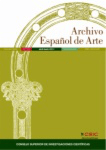
ARCHIVO ESPANOL DE ARTE
Fostering Innovation in Artistic ScholarshipARCHIVO ESPANOL DE ARTE is a distinguished journal dedicated to the exploration and dissemination of research in the fields of visual arts and performing arts. Published by CONSEJO SUPERIOR INVESTIGACIONES CIENTIFICAS-CSIC in Spain, this journal has been an open access publication since 1996, facilitating unrestricted access to valuable scholarly content for researchers, professionals, and students alike. With an E-ISSN of 1988-8511 and a commitment to covering a range of artistic phenomena, it plays a significant role in advancing the understanding and appreciation of art within both academic and cultural contexts. Although currently categorized in the Q4 quartile within its discipline, its ranking within Scopus—at #400/667, placing it in the 40th percentile—reflects its contributions to the broader discourse in art research. The journal's suite of open access offerings ensures that cutting-edge research remains accessible, fostering collaboration and innovation in the ever-evolving landscape of the arts.

Experiment-A Journal of Russian Culture
Discovering the Intersections of Literature, Art, and HistoryExperiment-A Journal of Russian Culture is a distinctive publication dedicated to exploring the multifaceted dimensions of Russian culture, encompassing literature, art, and social history. Published by BRILL, a respected name in academic publishing, this journal provides a platform for original research and insightful discourse, fostering a deeper understanding of Russia's rich cultural heritage. With an ISSN of 1084-4945 and an E-ISSN of 2211-730X, the journal is organized in a quarterly format, although it has seen varied publication years from 1996 through 2023. While it currently holds a Q4 ranking in both Cultural Studies and Visual Arts and Performing Arts, its commitment to interdisciplinary inquiry makes it a vital resource for researchers, professionals, and students interested in contemporary and historical Russian cultural phenomena. Despite its modest impact factors, the journal remains an essential platform for the dissemination of critical perspectives and theoretical frameworks, contributing to the ongoing dialogue about Russian identity and its artistic representations. The journal is available in print and may have limited digital access options, making it all the more precious for collectors and libraries committed to cultural studies.
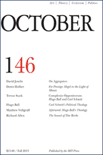
OCTOBER
Cultivating Thoughtful Analysis in Literature and the ArtsOCTOBER is a seminal journal published by MIT PRESS that spans a diverse array of interdisciplinary themes within the humanities, specifically focusing on literature and literary theory, music, and the visual arts and performing arts. Established in 2002, this journal has become a cornerstone for scholars and practitioners seeking critical discourse and innovative research across its converged fields, maintaining a respectable impact factor that attests to its influence in academic circles. While OCTOBER currently does not offer open access, it provides valuable insights and analysis that drive contemporary thought and discussion, positioned in the Q2 and Q3 quartiles of Scopus rankings. The journal’s commitment to high-quality scholarship makes it an essential resource for those looking to deepen their understanding of cultural and artistic practices, reflecting the evolving landscape of the arts and humanities from a rigorously theoretical perspective.

Quiroga-Revista de Patrimonio Iberoamericano
Empowering Scholars to Shape the Future of Heritage ConservationQuiroga-Revista de Patrimonio Iberoamericano, published by UNIV GRANADA, is a distinguished open-access journal dedicated to the fields of conservation, museology, and the visual and performing arts. Since its inception in 2012, the journal has provided a platform for scholars and practitioners to disseminate innovative research and critical discussions pertinent to Ibero-American heritage. With a growing impact, evidenced by its category quartiles ranking—Q3 in Conservation and Q2 in both Museology and Visual Arts and Performing Arts—as well as its Scopus rankings, Quiroga serves as an essential resource for researchers, professionals, and students who engage with the complexities of cultural preservation and artistic expression. The journal’s commitment to open access ensures the widespread availability of knowledge, fostering academic dialogue and collaboration within the global community. For inquiries, the journal can be reached at their offices located in Granada, Spain.

GOYA
Fostering Dialogue Among Artists and ScholarsGOYA, published by the esteemed FUNDACION LAZARO GALDIANO, is a pivotal journal in the field of Visual Arts and Performing Arts. With an ISSN of 0017-2715, this Spanish journal serves as a critical platform for scholars, artists, and practitioners to engage with contemporary issues, trends, and methodologies in the arts. Since its inception, GOYA has strived to illuminate the intersection of artistic expression and cultural discourse, with coverage spanning from 2002 to 2024. The journal proudly holds a Q3 category ranking in the 2023 Scopus assessments for its field, reflecting its respected position among peers, with a notable rank of #377 out of 667. Though it does not follow an Open Access model, GOYA continues to contribute significantly to the academic landscape, enabling a deeper understanding of artistic practices and their societal implications. Researchers and students alike will find the journal an invaluable resource for insights and inspiration within the dynamic realm of the arts.

CONNAISSANCE DES ARTS
Fostering Scholarly Engagement with the ArtsCONNAISSANCE DES ARTS, published by SFPA-CONNAISSANCE ARTS, is a prominent French journal that has been enriching the landscape of Visual Arts and Performing Arts since its inception in 1969. With an ISSN of 0293-9274, this journal offers a platform for critical exploration and scholarly discourse, making notable contributions especially in the realms of art history, criticism, and contemporary artistic practices. Although the journal currently holds a Q4 quartile ranking in its category and ranks in the lower echelon of Scopus ranks (#638 out of 667), its focus on niche topics within the arts makes it a valuable resource for researchers and professionals who seek to engage with less mainstream topics that often go overlooked. The journal publishes insightful articles, reviews, and essays, contributing to the nurturing of artistry and culture in France and beyond. While it is not an open-access publication, the journal remains a significant entity for academics and practitioners keen on advancing their understanding of visual and performing arts. For further engagement with the journal, interested parties can reach out or submit inquiries to its address at 51 RUE VIVIENNE, 75095 PARIS CEDEX 02, FRANCE.

Taida Journal of Art History
Advancing critical discourse in art history and beyond.Taida Journal of Art History, published by NATIONAL TAIWAN UNIVERSITY, GRADUATE INSTITUTE OF ART, is a pioneering academic journal dedicated to the exploration and critique of art history, particularly within the unique cultural context of Taiwan. Since its inception in 2018, the journal has become an important platform for scholarly discourse, offering insights into the evolution of visual arts and performing arts, alongside comprehensive studies in history. With an ISSN of 1023-2095, it currently ranks within the Q4 category in Arts and Humanities (Miscellaneous) and the Q3 category in History and Visual Arts and Performing Arts, indicating its growing influence in these fields. Researchers, professionals, and students alike can benefit from its rigorous peer-reviewed articles that bridge theoretical frameworks with practical applications, making it an essential resource for those engaged in the arts and humanities. This commitment to fostering academic excellence is reflected in its Scopus rankings, where it stands at Rank #338/667 in Visual Arts and Performing Arts and Rank #1027/1760 in History. Engage with the Taida Journal of Art History to gain deeper insights into the evolving narratives of artistic expression.